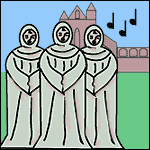Gregorian Chant
Created | Updated Jan 20, 2011

Our modern ears are used to hearing harmony, whether we prefer classical, rock, jazz, pop, country, alternative, or any of the numerous other genres of music. Harmony provides a rich aural texture to music, and many works sound incomplete without the many layers of notes one finds underneath the prevailing melody. However common harmony is in today's music, it was not always as crucial to the composition. In the early centuries of Christianity, liturgical chants were adapted and developed from the religious songs of the Jewish synagogues. Throughout the medieval period, these songs metamorphosed into the new tradition of religious chant. The chants of the area ruled by the Carolingian Dynasty (modern-day France, Germany, and Switzerland) began to be known as Gregorian chant.
Gregorian chant evolved as part of the Franco-Roman rite, one of many regional systems of worship that developed after Christianity began to be worshipped publicly in the 4th Century AD. It was said to have been originated by Pope Gregory the Great, who reigned from 590 to 604, but it is more likely that it was named after him simply to increase its authority. A Western system of musical notation did not appear until at least the 8th Century, so the chants were learned orally. The Gregorian chants were originally practised by monks reading the Bible aloud in church, and the 'readers' adopted a monophonic singing style. This monophonic style is still known as plainsong or plainchant because of the absence of harmony.
The use of Gregorian chant was increased under Charlemagne's Frankish kingdom, as he wished the Church music to be sung as in Rome. Gregorian chants were almost always sung by men since women were obligated to remain silent in church, except for the nuns in convents.
Notation
The exclusively vocal, non-harmonic Gregorian chants were first written simply as text until square notation was developed. Square notation consisted of symbols known as 'neumes that imitated vocal inflections by relating pitches on paper'. Neumes appearing relatively higher on the page called for higher pitches; lower neumes meant lower pitches. Sometimes the monks scribed horizontal lines representing specific pitches using a fingernail or ink to keep the neumes organised. This system was inaccurate, but it was a breakthrough that led to the familiar round notes and staff in modern notation. The system of neumes was complicated and proved useless to anyone who did not already know the melody, so duplicating a particular performance was difficult if not impossible.
Guido d'Arezzo (c 1000-50), one of the most important medieval music theorists, built on the idea of marking chant manuscripts with horizontal lines to invent a four-line staff that is still used in modern plainchant. Guido also invented solmisation syllables - ut, re, mi, fa, sol, la - and the hexachord system to facilitate the teaching of singing. The foibles of his developments are that his new notation system failed to indicate rhythmic relationships between notes and failed to reflect the modes, or scalar patterns, in which the songs were written. However, the absence of rhythmic continuity gives chant a spiritual quality and separates it from the secular practices of dance and martial display.
Some of Gregorian chant's interest lies in its use of eight modes. Classical and Romantic music was written in two modes, major and minor, and Oriental music used many more. The names of the modes were Greek, and there were four pairs. The first of each pair is 'authentic' - their ranges were above the final of the mode (the note on which most chants in that mode end), and the second is 'plagal'- the range is below the final. Each pair was named according to the Greek ordinal numbers (protus, deuterus, tritus, and tetrardus), and the authentic modes were also given Greek names (dorian, phrygian, lydian, and mixolydian). The plagal modes were named by adding the prefix 'hypo-', meaning 'under', to the names of the authentic modes.
Chant repertories were filled out during the 6th and 7th Centuries for each major city, region, and monastery. Each then had a set of psalm refrains and chants for the Mass and the Divine Office. The Divine Office was the daily cycle of prayer services to which psalmody was essential. Each region had a unique tradition, or rite, with special texts and melodies. Each locality developed a liturgical calendar of saint days and important events. Therefore, chant texts in specific localities usually referred to relics and saints venerated in the church buildings.
The Mass consisted of two groups of chants: the Ordinary, which remained the same for each service, and the Proper, which changed with the season or according to which saint was being worshipped. The Ordinary chants included the following: 'Kyrie', 'Gloria in Excelsis', 'Creed', 'Sanctus and Benedictus', and 'Agnus Dei'. The Chants of the Proper were 'Introit', 'Gradual' or 'Alleluia', 'Alleluia' or 'Tract', 'Offertory', and 'Communion'. The services of the Divine Office included Matins or Vigils (the Office of Readings), Lauds (Morning Prayer), Prime, Terce, Sext, None, Vespers (Evening Prayer), and Compline (at the end of the day).
Today modern chant is widely researched, and good examples of Gregorian chant are found in the books of the monks of the Abbey of Solesmes in France. These monks have carefully researched, compiled, and performed chant for over a century and a half. Gregorian chant has recently enjoyed a resurgence in popularity due to the release of the Chant album of the Benedictine monks of Santo Domingo. Their album's explosive success has reintroduced the world to the simple beauty of liturgical chant and monophony.
Bibliography
The Chant in Latin - The Gregorian Association (UK), 1997
Medieval Music, Richard H Hoppin, New York: WW Norton and Company, Inc, 1978
Politoske, Daniel T Music. Upper Saddle River, NJ: Prentice Hall, Inc, 1992
Ratio Studiorum: the Shape of Modern Chant Studies - The Gregorian Chant Home Page, 1996

